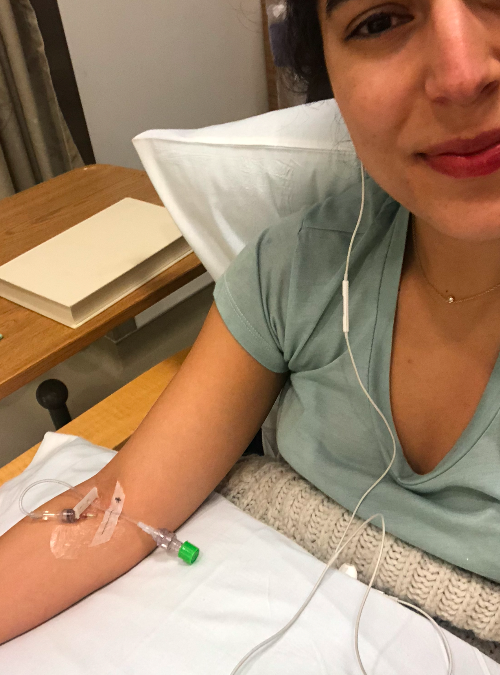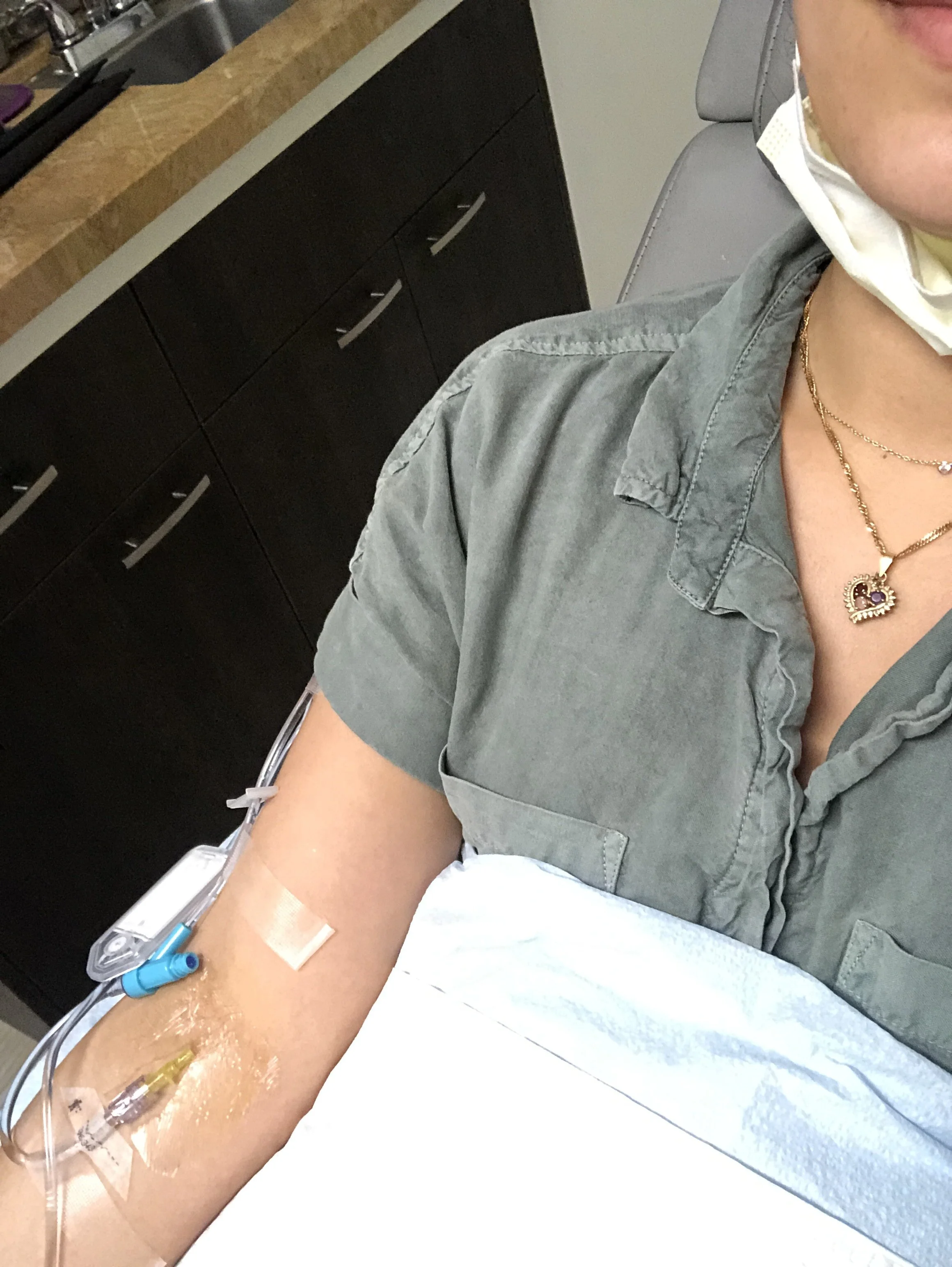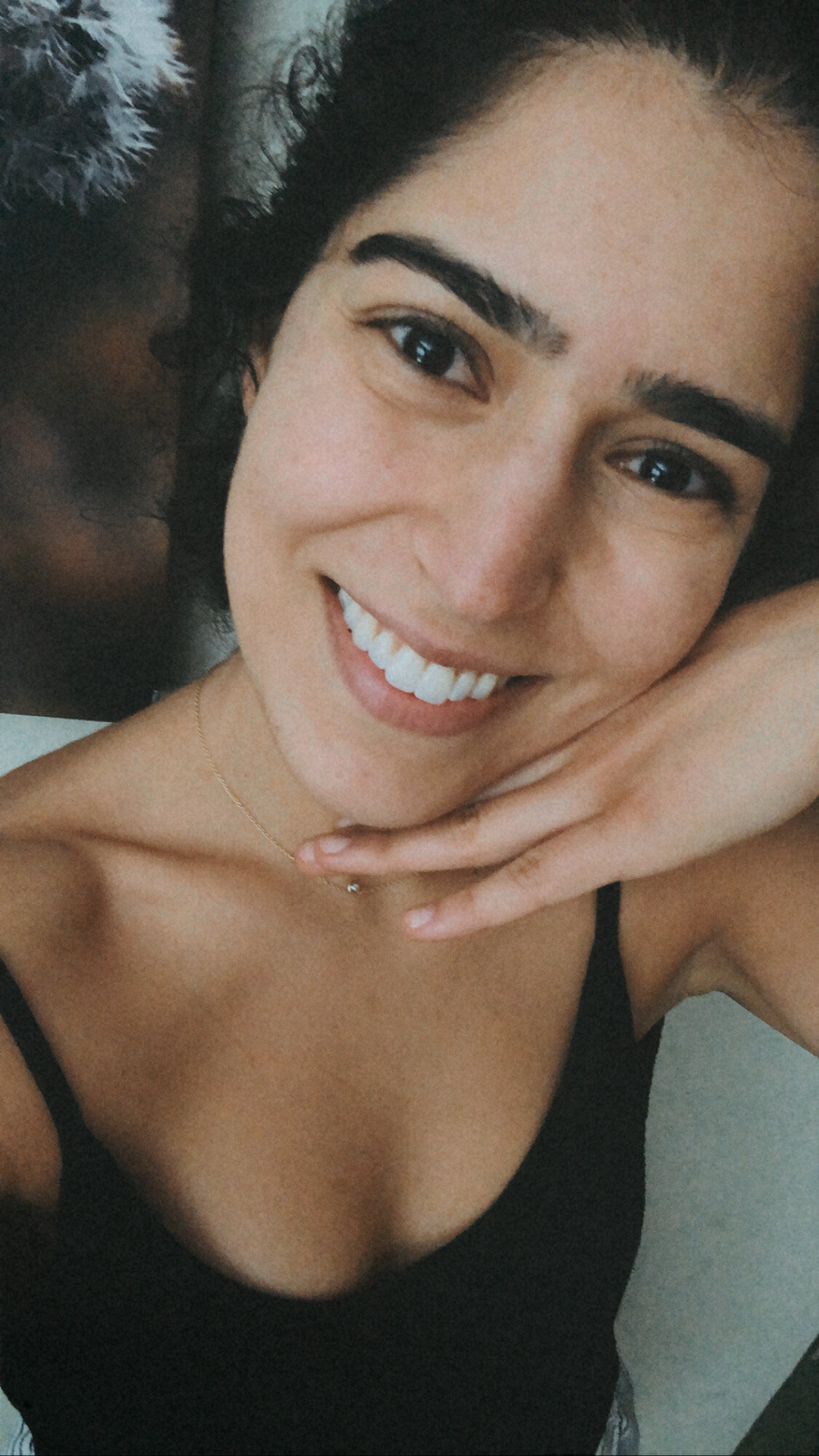Less than two years after I was diagnosed with Graves’ Disease, my eyes began to show signs of Graves’ Ophthalmology or Thyroid Eye Disease (TED) as more often referred to.
I didn’t even notice it at first. The bulging of my eyes; “the stare” is what they call it.
Through a referral by my initial Endocrinologist (I went through a handful before I found the right one), I made an appointment to visit one of the top Oculoplastic Surgeons in the country, who also specializes in TED, to receive a diagnosis.
*In referencing the first Oculoplastic Surgeon I was referred to, he is renamed to Dr. Rogers, since I no longer see him*
2013: My First Appointment with Dr. Rogers
My first visit was beyond intimidating. I was escorted into an examination room with close to 10 residency students and soon after, Dr. Rogers. Understanding that this was a teaching opportunity for all of them, I gave consent for each student to run the same tests and measurements on me.
This initial appointment took nearly 3 hours, and concluded with Dr. Rogers diagnosing me with early onset Thyroid Eye Disease. His prognosis was telling me that once my thyroid levels normalize and are stable for a period of time, the eye condition would also improve.
Please keep in mind that Graves’ Disease and Thyroid Eye Disease are two separate autoimmune conditions. The status of one, does not influence the other.
After that appointment, I visited Dr. Rogers annually to have my eyes measured and track the progression of the disease. My eyes were relatively stable for years to come, until 2017.
August 2017
I woke up one morning to find that I had a bout of swelling underneath my left eyebrow. It looked like an ingrown hair that maybe got infected. I didn’t think anything else of it and went on with my day.
The following morning, the swelling had grown large enough to cover my entire eyelid and made it impossible for me to open my eye. Needless to say, I began to panic.
I did hot compress that entire day, but the swelling wasn’t going down. Because I initially assumed that it was an ingrown hair, I had made an appointment to visit a Dermatologist that same week. At that appointment, because it was so swollen and thus hard to tell what it was or how large it truly was in size, I was given a cortisone shot to decrease the inflammation. The only way to determine that was to bring the swelling down and examine it from there.
Once the swelling had tapered down after two rounds of cortisone shots, I went back to the Dermatologist to have it looked at and she suspected that it was an infected cyst; which is very common and I was told not to worry. I was referred by her to visit a Plastic Surgeon to discuss removing the cyst, since this was on my face and in a very delicate spot, we wanted to make sure whomever removed it would do it with precision. Thankfully I was able to see the Plastic Surgeon that same day and after that visit, he reassured me that I was in safe hands. To this day, I would recommend him - his work is flawless and his demeanor is unmatched.
After a week or two, the swelling had decreased enough to where I could finally have the cyst removed. The surgeon removed what turned out to be a benign skeletal muscle tumor (again, super common), in one swoop and did an absolutely beautiful job of it.
The incision spot did get infected twice after the surgery, so I had to have two more rounds of cortisone shots on it. But other than that, the recovery period was quick and seamless.
A month or two after the surgery, I happened to have a routine appointment with Dr. Rogers. I mentioned the cyst removal and asked him if this should raise any concern in affecting the progression of Thyroid Eye Disease. He expressed zero concern, but my gut told me otherwise. I decided to trust his instinct and professional opinion, but about 10 months after this appointment, my left eye, the one with the removed cyst, started to show signs of protrusion.
This all begged me to ask: was this happening because of the cyst or did the surgery to remove it perhaps cause atrophy?
I made an appointment to see Dr. Rogers and asked him these very questions. He again replied that this incident will not cause aggravation of Thyroid Eye Disease and what I was noticing of my left eye just happened to be a bump on the TED road - but the two situations are not related.
Again my gut, was telling me otherwise…
When something feels out of alignment in my body, I notice it immediately. I am grateful to know what it feels like to not be symptomatic, so I will notice when something is even slightly off.
2019,
Time since then had passed and my left eye progressively got worse. And then there was a point where I felt like something was in my head. As in, physically in my head. I kept having this really negative dialogue with myself that maybe there was something causing my eye to bulge forward. Maybe there was excessive swelling or inflammation from the surgery that hadn’t cleared. Whatever it was or wasn’t, I knew that something was off.
I wanted to address this concern with Dr. Rogers. At my next regular visit, I expressed these concerns with him, told him that I really felt like something was happening behind my eye and I wanted a CAT scan to prove/disprove this. He told me that a CAT scan would be useless and not give us any answers.
At this point, my gut instinct was screaming and sounding the alarms.
That same evening, on a whim I typed into Google “Thyroid Eye Disease.” I came across this ongoing study, being conducted by Dr. Raymond Douglas for a treatment for Thyroid Eye Disease. I fell into the Google black hole for hours, reading every published article and study available, as well as Dr. Douglas’ bio and credentials. I decided that I wanted to speak to him and when I saw that his offices just so happened to be located near my Endocrinologist’s, I called the next morning and made an appointment.
Discovering Craniosacral Therapy
Prior to my visit with Dr. Douglas (actually, the same night that I Google deep dove and found him), I was researching holistic modalities for cranial and eye health. That was the night that I discovered Craniosacral Therapy (CST). After reading a handful of Yelp reviews, I came across Emma Julaud’s page. She seemed sweet, endearing, gentle – exactly what I wanted. We chatted on the phone a few days later and after hearing her voice and learning more about her and CST, I was eager to give it a try.
Craniosacral Therapy is a form of bodywork or alternative therapy that uses gentle touch to palpate the synarthrodial joints of the cranium. It can help to improve the functioning of the nervous system, relieve pain and improve mobility. CST has been used to treat a variety of conditions, both physical and psychological.
My first session with Emma came at such a perfect time, because I was experiencing the most insane headache for nearly a week. The pressure and pain that I was feeling was only on the left side of my head and wrapped around my left eye orbit. I could barely keep my eyes open without feeling pressure every time I blinked and any exposure to light was excruciating.
Emma is a healer, without a doubt. I didn’t know what to expect during our session and I’m glad that I was able to go in without expectation and surrender to the experience.
After that first session with Emma, the headache went away completely and I knew that this was something I wanted to upkeep on a weekly basis. I continued with CST at that point, all the way until the end of my treatments with Tepezza.
My First Appointment with Dr. Douglas
The day came for my initial appointment with Dr. Douglas. I came prepared, with all my medical records, photographs and questions. Dr. Douglas sat with me for over two hours and I finally felt seen, heard and safe.
I was sharing with him my journey up until that day and eventually told him about the most recent incident with the cyst removal and my concerns related to it. When I told him my suspicion about whether the surgery could have caused atrophy and thus exasperate TED symptoms, he agreed. He confirmed that that surgery most likely did cause a trauma to my eye and thus, my eye is now showing signs of TED. Apparently this type of reoccurrence happens in 4% of patients - making me a rare case. I told him how I felt like there was something physically behind my eye and I wanted a CAT scan to see what that was about. He was already considering me having a CAT scan and put the order in on my way out the office.
CAT Scan Results
“Psuedotumor.”
I broke down in tears. And these weren’t tears out of fear, rather tears of relief. Finally, I had an answer. And all this time that I had been saying that I felt as if something was behind my eye. Turns out, it was true.
A Pseudotumor means “false tumor.” Essentially, it is a significant amount of inflammation that manifests into what our body thinks is a tumor - thus why I had been feeling so much pressure behind my eye.
As I was processing this newfound information, I knew that I wanted to do everything and anything to alleviate the inflammation, before turning to a more invasive approach.
A few weeks later, I went in to see Dr. Douglas for a follow up and review my CAT scan results in person. In the meantime, Dr. Douglas advised me to do what I can to alleviate the discomfort that I am experiencing – through whatever holistic modalities I had access to. We also discussed the possibility of me being treated with the new medicine he had been working on using for his TED patients, Tepezza.
Late November of this 2019, Dr. Douglas recommended that I proceed with a round of steroid IV treatments, to help alleviate the size of the pseudotumor and the symptoms I had been experiencing associated to it. These treatments were incredibly helpful and some of the biggest symptoms that I had from TED (such as double vision and pressure) were nearly 50% reduced.
March to April 2020
After almost a year of implementing holistic modalities and monitoring the progression of my eyes, the time came to consider the use of Tepezza.
Speaking with Dr. Douglas and reviewing my case, we decided that orbital decompression surgery would not be the first choice to alleviate the condition that my eyes were in. Given my recent history of experiencing atrophy from a minor cyst removal, it was likely that I would not respond favorably from surgery, and thus we decided to move forward with Tepezza.
Once the logistics were all taken care of, I made my first appointment to begin receiving Tepezza on April 22, 2020.
From April 22nd, 2020 to September 18th, 2020 I was receiving Tepezza treatments. The treatment is administered in an IV, 8 sessions every 3 weeks.
Between each infusion period, I also received vitamin IV therapy at my Naturopathic Doctor’s office; to help keep my immune system strong and also avoid some of the common side effects of Tepezza, such as muscle cramping. Throughout the course of Tepezza treatments, I started to notice first gradual and then drastic improvements to the physical appearance of my eyes and the symptoms associated with TED.
Tepezza FAQ
Some common questions that I am asked about my Tepezza experience.
“What side effects did you experience?”
The usual side effects that can occur when receiving Tepezza are:
Muscle cramps or spasms
Nausea
Hair loss
Diarrhea
Feeling tired
High blood sugar
Hearing problems
Taste changes
Headache
Dry skin
Loss of menses
The symptoms experienced are typically very short lasting and go away a month or two after finishing Tepezza. I spoke with two other ladies prior to beginning my Tepezza treatments and both of them also said that their side effects were very minor and went away soon after.
Personally, I lost my menses after my second or third treatment and it came back two months after I finished Tepezza. I also had very minor ear ringing and a temple headache 1-2x a week that lasted less than a minute at length. Incredibly tolerable and hardly noticeable.
“Did you do anything significant during the time you were receiving Tepezza?”
I focused on eating an anti-inflammatory diet throughout my treatment period and I received vitamin IV between every other treatment. My vitamin IVs were a Myers Cocktail with glutathione, magnesium and an extra dose of vitamin C. Please be sure to speak with your healthcare provider before incorporating vitamin IV into your regime.
I also focused on prioritizing my sleep, keeping my stress low and weekly visits to Emma for CranioSacral Therapy sessions.
“How did you feel after each infusion?”
I felt great! After my first infusion and the sixth, I was a little fatigued. On the day of each infusion, I made sure to not do anything strenuous even if I felt fine.
“Were you limited in your day to day activities?”
Nope! Not at all.
My progression from Tepezza #1 to Tepezza #8!
A Note of Gratitude and Guidance for all with TED,
I’ve come to learn that as long as we don’t associate or personalize ourselves to whatever the condition is, the less that very condition will further manifest to greater lengths. It is definitely a daily practice.
It’s so easy to drop into a state of judgement, disappointment, frustration and uncertainty. I have had days where I just burst into tears, days where I avoid looking at myself in the mirror, days where I resist taking a photo with a friend because the first thing I notice is my swollen eye. And even though this particular part of my journey has been trying, I knew that the light was there. I knew that I am going to be healed from this very soon.
The only way to get there, is to trust. Is to surrender. Is to turn love inward and remind yourself of how far you have come and how powerful you are.
I am so honored to be in this body. I am so grateful to have the fortune of taking care of this body. I am so inspired by what this body has, can and will continue to do. I don’t take any of that for granted. I really and truly am, so blessed.
Resources for those with TED:
ThyroidEyes.com was created with guidance from the TED community to provide education and community for those who are at risk of developing TED
oneGRAVESvoice.com is a resource made possible through an unrestricted grant to the Graves’ Disease and Thyroid Foundation to connect, educate and empower the Graves’ disease and TED communities
Bromberg Translation and Telephonic Interpreting Services at BrombergTranslations.com is a no cost program offering translation and telephonic interpretation services for Spanish speaking individuals and families impacted by specific health conditions
Patient Advocate Foundation’s Rare Disease CareLine at RareDisease.PAFCareLine.org provides support and assistance to patients with chronic, debilitating disease to help access care and treatment recommended by their doctor(s). Case managers will help navigate roadblocks to access to care and affordability to Americans with chronic, rare and ultra-rare illnesses
National Organization for Rare Disorders (NORD)
The Assistance Fund at TAFcares.org
Patient Advocate Foundation at PatientAdvocate.org
And other organziations for those with TED including American Foundation for the Blind, American Thyroid Association, Autoimmune Association, Center for Chronic Illness, Global Genes, Graves’ Disease and Thyroid Foundation, National Federation of the Blind and Prevent Blindness




